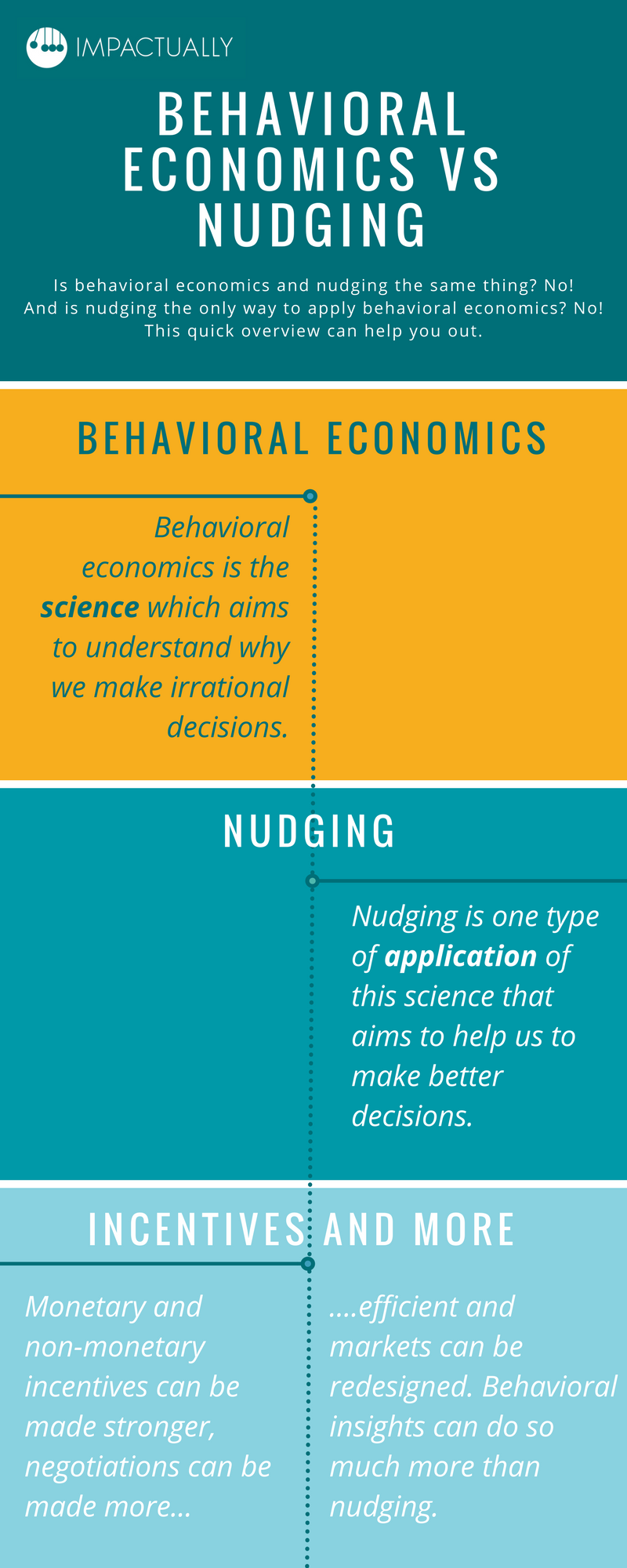Behavioral Economics and nudging – same difference?

If you happened to come across Impactually then you have probably heard about behavioral economics and about nudging (if not, you might want to check our articles about what Behavioral Economics is and how it is used in practice). But still you might not be completely sure what the difference is or if it is just two words for the same concept. So let’s briefly clear this up. For a very short definition, check out the infographic below!
Behavioral economics is a sub-field of economics, which aims to explain why humans behave less rational than traditional economics assumes they do. Behavioral economics is a science that develops models of human decision making by taking inspiration from social psychology to adjust neoclassical economic models of utility maximization. A behavioral economist can take practically any human decision and turn it into a mathematical formula. This formula then allows us to predict how people will make decisions – at least on average. For a great overview of all the areas of behavioral economics see this article on BE Hub.
Nudging on the other hand is one particular type of application of insights from behavioral economics in order to influence decisions. Nudging is not a science but an application of a science, behavioral economics. When we talk about nudging we mean that we design an intervention meant to affect behavior without changing the monetary incentives and without restricting anyone’s choice. The term nudging was born when Thaler and Sunstein’s publisher suggested they come up with a better name for their book, which was pitched with the name “libertarian paternalism”. What is that? Paternalism is any action that limits your choices for your own good. Like when parents don’t allow eating chocolate before lunch. Libertarian paternalism doesn’t take away the chocolate, but makes it harder to reach or wraps it in very small portions, so it is harder to eat a lot without thinking.

If nudging is just one way of applying behavioral economics to influence decisions then what are other ways?
Incentives can be designed with behavioral economics in mind. For example, people are irrationally attracted by things that are free. They also love lotteries because they overvalue small positive probabilities. If you want to encourage some good behavior, like taking the bike to work, you might enroll everyone that has chosen to comply into a lottery. Every day that people get to work by bike they get entered into a lottery. This is not a nudge because it uses monetary incentives to get people to change their behavior, but it is an incentive that relies on humans being irrational, and therefore, still part of behavioral economics and the kind of interventions we design at Impactually.
Reducing or adding options can also be a powerful way of changing behavior. Adding a more expensive wine to the wine list, makes the wine which is now the second most expensive one more attractive by comparison. Now there is a now more outrageous option. This is also not a nudge because we have added a new option which wasn’t there before. People react to this added option by liking the second most expensive wine more than they should if they were fully rational, but a nudge should not increase or decrease the choice set.
Behavioral economics is the science which aims to understand why we make irrational decisions, nudging is one type of application of this science that aims to help us to make better decisions.
While nudging is great and is quite in at the moment insights from behavioral economics enable us to re-design markets, employer-employee relationships, bonus systems, negotiations, contracts and so much more to improve people’s lives and create an impact in society. Reducing the influence of behavioral economics on nudging alone would be wasting the huge potential of applying a science that is so much more than just a nudge.
Want to hear us talk more about behavioral economics and nudging? Check out the preview of our online course “Get behavioral science to work for you”, at the bottom of the course page.
You can also download our free and easy-to-use Introductory Guide, which introduces the foundations of the field for people who want to work with behavioral science and nudging in practice.
—

Christina Gravert
christina.gravert@impactually.se
+46 76 070 33 89
I want to learn more!
We hear you. If you’ve already read our post about what behavioral economics is, and how it can be used in practice, then here’s a list of books, TED Talks and other online resources. Other interviews, articles and videos we have published elsewhere can be found here. You are also welcome to sign up to our newsletter, where we give you relevant news and links on behavioral economics.
I’m convinced that behavioral economics can do wonders for me. Now what?
Contact us and let’s talk about how we can help you get going.

We are a management consultancy applying behavioral insights to create business and societal impact. We use our expertise in behavioral economics and social psychology to design evidence-based solutions to critical challenges. We leverage scientific methods to identify interventions that will have long lasting, measurable effects.
DISCLAIMER
FOLLOW US
CONTACT
Email: info@impactually.se
Org. no.: 559167-0327
Web Design: Sharp Studio
Copyright Impactually 2024
